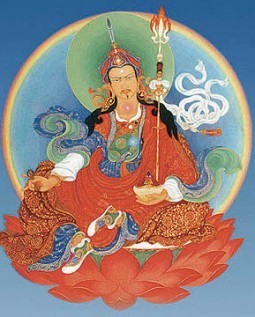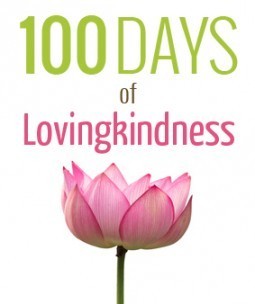Knowing the mind of the Buddha
 A little under two years ago I was on a retreat with other members of the Triratna Buddhist Order, which I’ve been a member of since 1993. We were discussing the visualization meditation practices we were each given at the time of our ordination.
A little under two years ago I was on a retreat with other members of the Triratna Buddhist Order, which I’ve been a member of since 1993. We were discussing the visualization meditation practices we were each given at the time of our ordination.
At the time of my own ordination, the practice I had requested and was formally given — the visualization of Padmasambhava — was described as being my orientation toward enlightenment. The visualized form of Padmasambhava — a red-robed figure with a trident and skull cup overflowing with the nectar of immortality — embodied my personal connection with awakening.
“Enlightenment” can be a rather abstract concept. How can we aim to attain a state if we have no feel for what it’s like to experience it? Imagine that you wanted to develop the quality of kindness, but had no examples of kind people to inspire you? Developing the quality of kindness wouldn’t be impossible, but it would be a lot harder. So it’s helpful to develop a clear and embodied sense of what an awakened being is like, so that we can resonate imaginatively and emotionally with it (which is now no longer an “it,” but a “he” or a “she”).
I started my contribution to the discussion without much enthusiasm, because my practice of the visualization of Padmasambhava had fizzled out a long time ago, and I didn’t feel good about that. When I was ordained there was a lot of stress put on doing the visualization practice regularly, and although I’d started off well, I found visualizing to be very hard. I’m actually a very visual person, but I had some kind of block regarding the practice.
 Actually, before my ordination, I had a very strong personal connection with Padmasambhava. I had many dreams about him, and sometimes when I looked at pictures of him I’d “hear” him speaking to me — often giving me very useful advice. (No, I’m not crazy; I’m aware this was really me speaking to myself.) I spent months sculpting his trident, which is very elaborate, and then rowed out into the middle of a loch in the Scottish Highlands and offered the trident up to the depths. My connection with Padmasambhava was a big deal for me.
Actually, before my ordination, I had a very strong personal connection with Padmasambhava. I had many dreams about him, and sometimes when I looked at pictures of him I’d “hear” him speaking to me — often giving me very useful advice. (No, I’m not crazy; I’m aware this was really me speaking to myself.) I spent months sculpting his trident, which is very elaborate, and then rowed out into the middle of a loch in the Scottish Highlands and offered the trident up to the depths. My connection with Padmasambhava was a big deal for me.
Somehow the meditation practice I was given interfered with all this. Struggling with the visualization made me feel that there was a barrier to communing with Padmasambhava, and gradually that sense of connection faded away, and I stopped doing the meditation practice.
And there was a sense of shame about my lack of fidelity that came up as I talked on the retreat about how I’d ceased doing this visualization practice. But as I continued to talk about how I’d been exploring alternative approaches to awakening that were more rooted in direct experience, I realized that I had never lost my fidelity to an underlying quest, which I expressed that day as wanting to know the mind of the Buddha.
This was the quest I’d been involved in even before I encountered the Buddha. Even in my teens I knew there was an alternative, more real, and more satisfying way to experience the world. There was a different way to see, and a different way to be. And I wanted to know what that was like. I wanted to experience the world that way — whatever “that way” was.
When I encountered the Buddha’s teachings — and even more when I encountered the Mahayana Perfection of Wisdom Sutras — I was aware of being in the presence of that different way of seeing. And I wanted to know the mind of the Buddha.
Although I’d stopped visualizing Padmasambhava, knowing the mind of the Buddha was always my goal. And my connection with Padmasambhava was just one particular way to seek that goal.
Now, just as mudita is the joyful appreciation of the skillful in others, where the good in us resonates with the good in others, so I believe that upekkha can involve valuing and appreciating the insight that others have. It’s that within ourselves that seeks insight resonating with the insight in others. Upekkha involves wishing the highest possible good — the benefits of awakening — for others. And so we naturally respond with gratitude, respect, and even devotion, to those who embody awakening. And that in fact is the point of the practice of visualizing enlightened beings.
The Buddha himself (or possibly his early disciples) seems to have encouraged this way of approaching awakening, and there was a practice that they called “Buddh?nusati” — reflecting on the Buddha and allowing ourselves to resonate with his qualities.
And I think that Buddh?nusati can be an important part of our upekkha practice. I discussed a couple of days ago how we have to be engaged in a quest for awakening ourselves before we can really wish awakening for others. And I think that it’s helpful, if we’re on a quest for awakening, to develop a sense of a personal relationship with awakening.
This doesn’t necessarily have to take the form of a visualization meditation. That didn’t work out well for me, although perhaps I gave up too soon.
It could take the form of having pictures of Buddhas and Bodhisattvas on our walls, or on our phones or computer screensavers.
It can take the form of reading the Buddhist scriptures (many are available free online) and allowing ourselves to get to know the Buddha from the records that have been passed down to us. This may not be an easy thing to do, because much of the depth of the Buddha’s personality has been flattened by centuries of oral repetition. But enough of the Buddha still shines through for us to have a sense of his extraordinary personality.
It can take the form of having a Buddha statue on the altar we meditate in front of. Don’t have an altar? I’d suggest putting one together. It doesn’t need to be elaborate.
It can take the form of bowing to Buddha images. Bowing doesn’t mean subservience. It’s simply a respectful greeting. And so every time I walk into a meditation hall, I bow. This reminds me of my debt of gratitude to the Buddha.
It can take the form of chanting verses. This is done in every Buddhist tradition that I know of. In the Triratna Buddhist Community of which I’m a part, we have a number of texts that we commonly chant together. Some can be downloaded here, and there are various recordings here. The earliest forms of Buddh?nusati seem to have involved chanting.
And lastly, you can do visualization practices. This doesn’t have to the done in a formal way, but can be as simple as imagining that the Buddha is sitting beside you when you’re meditating. I often do this. I don’t even necessarily “see” anything, so visualizing isn’t the right word. But just as you can know someone’s sitting beside you when you have your eyes closed, you can imagine someone sitting beside you while you’re meditating. There’s a feeling of a physical presence. And what I often do is to drop in the words “Feel the love of the Buddha.” So not only am I experiencing the Buddha sitting beside me, I feel him as a loving presence. Often this results in a feeling of warm on the skin of the side of my body that’s nearest to him.
So we seek to know the mind of the Buddha, to get close to him and to develop an appreciation and respect for awakened qualities — qualities which we ourselves are bringing into being. And in the upekkha bhavana practice we can wish that those qualities manifest in others, so that they know the peace and joy of awakening.
Related posts:
Not knowing how near the Truth is, people seek it far away
The expansive mind of lovingkindness (Day 23)
Bearing compassion in mind (Day 43)
Related posts brought to you by Yet Another Related Posts Plugin.




